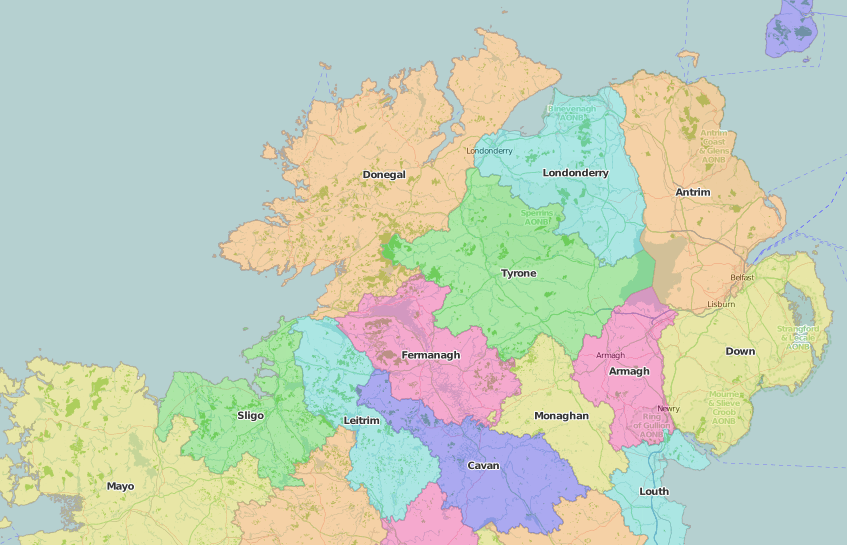
The ancient Irish province of Ulster – counties Antrim, Armagh, Cavan, Donegal, Down, Fermanagh, Londonderry, Monaghan, and Tyrone.
Speed liked the weather in Ulster: “Quick and flexible winds cool the heat of summer, and soft and gentle showers mollify the hardness of the winter” but his map (dated 1610) quickly became outdated, following James VI and I’s plantation of Ulster from 1609. The Ulster Speed visited had closer ties to the Gaelic Highlands and Islands of Scotland than the rest of Ireland (the edge of the Scottish coast appears in the map’s margins) and retained well-maintained medieval castles for defence, like the fort at Enniskillen shown on the map, and undissolved pre-Reformation religious foundations.
Evelyn Philip Shirley’s estate at Lough Fea, co. Monaghan remained tolerant towards the Catholic priesthood into the 19th century. Despite his political career, Shirley’s real interest remained genealogy, and he is depicted as Mr Ardenne in Benjamin Disraeli’s Lothair:
a man of ancient pedigree himself, who knew everybody else’s
Contemporary accounts of the colonization of Ulster by Speed’s contemporary, Sir John Davies, lawyer and poet, show his determination to replace Gaelic law with English, and Catholic with Protestant religion. They were reprinted throughout the 17th and 18th centuries, latterly edited by George Chalmers (1742-1825), who also supported British colonization in America.
The Knowsley Hall library contains several accounts of Elizabethan and later Irish rebellions against English imperialism.
The solid rocks underlying Ireland, whatever battles raged above them, was the proposed subject of a work by Joseph Ellison Portlock (1794-1864) to complement his topographical work on the Irish Ordnance Survey; the 1843 report on the Ulster counties of Londonderry, Tyrone and Fermanagh was the only part completed. The same year, the prominent future Belfast geologist, William Swanston (1841-1932) arrived in Carrickfergus from his birthplace of colonial Barbados. He was a keen collector of books by Oliver Goldsmith, and apparently much earlier printed books, as his bookplate and motto: Gesta verbis praevenient (Deeds before words) is in a volume of three texts of 1511 from our Early Printed Books collection.
Special Collections also has significant holdings of published and unpublished work by Seamus Heaney, most prominent of the Northern Irish poets of the late 20th century, including many first publications, first editions, and private press editions.
Special Collections classmarks of items cited:
- Evelyn Philip Shirley (1812–1882), Some account of the territory or dominion of Farney, in the province and earldom of Ulster (1845): SPEC Y84.4.6
- Sir John Davies (1569-1626), Historical tracts. Consisting of I. A discovery of the true cause why Ireland was never brought under obedience of the crown of England until his majesties happy reign. 2. A letter to the Earl of Salisbury on the state of Ireland, in 1607. 3. A letter to the Earl of Salisbury, in 1610; giving an account of the plantation in Ulster. 4. A speech to the Lord-Deputy in 1613, tracing the ancient constitution of Ireland. To which is prefixed a new life of the author, from authentic documents (1786): SPEC Y78.3.392
- Fynes, Moryson (1566-1630), An itinerary vvritten by Fynes Moryson Gent. First in the Latine tongue, and then translated by him into English: containing his ten yeeres trauell through the tvvelue dominions of Germany, Bohmerland, Sweitzerland, Netherland, Denmarke, Poland, Jtaly, Turky, France, England, Scotland, and Ireland. Diuided into III parts. The I part containeth a iournall through all the said twelue dominions: shewing particularly the number of miles, the soyle of the country, the situation of cities, the desciptions of them, with all monuments in each place worth the seeing, as also the rates of hiring coaches or horses from place to place, with each daies expences for diet, horsemeat, and the like. The II part containeth the rebellion of Hugh Earle of Tyrone and the appeasing thereof: written also in forme of a iournall. The III part containeth a discourse upon seuerall heads, through all the said seuerall dominions (1617): SPEC Knowsley 285
- Sir Audley Mervyn (-1675), An exact relation of all such occurrences as have happened in the severall counties of Donegall, London-Derry, Tyrone, & Fermanagh in the north of Ireland, since the beginning of this horid, bloody, and unparaleld rebellion there, begun in October last. : In all humility presented to the honourable House of Commons in England. By Lievetenant Collonell Audeley Mervyn, the 4 of Iune, 1642. SPEC Knowsley pamphlet 457(09)
- G. N., well-willer to the peace of both kingdoms, A geographicall description of the kingdom of Ireland. : According to the 5 provinces, and 32 counties; together with the stations, creeks, and harbours belonging thereto: fit for gentlemen, souldiers, and sea-men to acquaint themselves withall. As also declaring the right and titles of the kings of England unto that kingdom. Likewise setting down a brief relation of the former rebellions, and of their suppression; especially that in Q. Elizabeths time by Tyrone: whence many matters worth observing may be collected, usefull for this present service. (1642): SPEC Knowsley pamphlet 496(08)
- Joseph Ellison Portlock (1794–1864), Report on the geology of the county of Londonderry and parts of Tyrone and Fermanagh, examined and described under the authority of the Master General and Board of Ordnance (1843): SPEC Y84.3.776
- The Kilpeck anthology; edited by Glenn Storhaug. Includes Seamus Heaney, Sile na gig. No. 37 of 50 special copies designed, hand-set and printed by Glenn Storhaug at Five Seasons Press near Madley, Herefordshire (1981): SPEC S/Z239.2.F565.S88
- Maffeo Vegio, De perseverantia religionis libri septem [and 2 other works] (1511): SPEC EP.B15